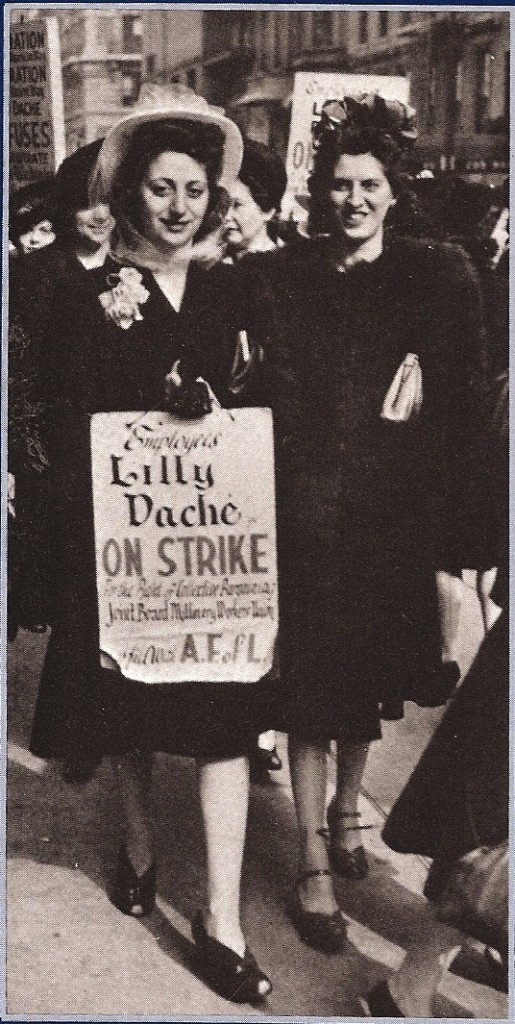By Mary Tuomanen
Pariticipating in the RIOT development process has made me pick up all kinds of books I would normally have passed over. While visiting my family over vacation, I walked out of a used bookstore in Newmarket, New Hampshire with this title: “Sisterhood and Solidarity: Feminism and Labor in Modern Times”, by Diane Balser. The cover sports a 1930s photograph of two white women holding picket signs. They are smiling; they seem to be pals, demonstrating solidarity and sisterhood. It’s like they are saying to me, “See? Like this!”

Balser published this book in the wake of the 1984 election. You can tell that though she tries to write with a degree of academic distance, the author clearly has the wind taken out of her. The re-election of Reagan seems to have been entirely unexpected for the feminist movement. Balser tries to piece together how it happened like someone who comes home to find their house has inexplicably fallen into pieces — the nails just fell out of the walls.
I understand that feeling. It was exactly how I felt on election night 2004, at a party hosted by a committed lesbian couple, where everyone else in attendance also happened to be a woman. We expected it to be a victory party. There were hors d’oeuvres on the table, left untouched. Everyone went to bed in stunned silence and my best friend Al and I stayed up, staring at the face of George W. Bush on the television, asking ourselves, “How could this happen on our watch?”
Balser is a woman of the left, like me. Like me in 2004, she found herself dumbfounded at the reelection of a conservative president whose policies had been devastatingly toxic to both women’s issues and organized labor. Like me, she began looking for ways in which movements of the left might be failing, and how they could be stronger. Why weren’t women voting in their own self-interest?
Something else I learned recently: many suffragettes in the late nineteenth century believed that women, once wielding the power of the vote, could end war and poverty. They truly believed that they would become an immediate and formidable force; they understood what Balser also understands, that “women make up the majority of most oppressed groups— i.e. older people, the poor, the working class, third world nations, people of color in the West, the physically disabled, etc.”
The fact that all women share a single gender identity and are simultaneously members of every other oppressed group is a source of both conflict and power. …Most importantly, women have access to every other oppression. Thus women cannot really end their own oppression without ending the oppression of all other peoples.
This passage blew my mind.
Is feminism — could feminism be — the fight to liberate all oppressed peoples?
Could it be? Yes. It MUST be.
Only then can we start getting things done.
The strength of the left has always been diversity, and today’s feminists must strive for what suffrage movements failed to achieve — a unifying of women of all classes, ages, nationalities, races and creeds. This does not just mean creating an inclusive platform, it means getting on board with EACH OTHER’S platforms. Black power = woman’s issue. Gay power = woman’s issue. Rights for First Nations = woman’s issue. Rights for the elderly, the disabled, all of these are OUR ISSUES.
So often activist movements these days try to follow a capitalist marketing model, crafting clear demands that can be communicated and sold like a product. In fact, this was the media’s major critique of Occupy — no clear goal, no clear endgame. On the contrary! Occupy’s major strength was to achieve what should be the goal of feminism: to make a horizontal structure that incorporates everyone’s hopes, everyone’s concerns, a complex dialogue among diverse peoples. Solidarity has no endgame. Rather, it is a continuous exercise in dialogue and compassion.
Why didn’t suffrage suddenly and dramatically forward the pacifist and humanitarian agenda as suffragettes believed it would? When women got the vote and then didn’t vote in each other’s interests, they lost the very power for which they’d fought. Middle class white women did this in particular, by preferring the interests of their class, their fathers or husbands, over those of their sisters. They disempowered themselves because they didn’t realize that solidarity has no endgame.
Sisterhood and solidarity!
Just as women cannot be liberated without fighting for the liberation of other oppressed peoples, Balser goes on to claim that by the same logic, “every other oppressed group must tackle sexism in order to be liberated.”
My friend Ian Peakes (a white male feminist) spoke to me recently about seeing Dr. Angela Davis speak when he was in college. She touched on Malcolm X and the evolution of his political thinking over the course of his short life. She said that if Brother Malcolm had lived a few more years, he would have become a feminist. I would like to believe that is true. I think anyone who contemplates the liberation struggle deeply and at length will come to the same conclusion — a just society involves compassion and equality for all, not just those in your own social group. (I reread Malcolm X’s autobiography after finishing Sisterhood and Solidarity, and I thank Diane Balser and Dr. Angela Davis for helping me realize that my responsibilities as a feminist must, necessarily, extend to confronting all mechanisms of racism. And the mechanisms of agism, homophobia, class difference, etc.) The fight against oppression is about casting our lot in with our fellow human beings, even before they’ve asked it of us. It means reading each other’s histories, trying our best to look through each other’s eyes, assuming compassion for the other even if it isn’t returned. Yet.
Yet.
A few more years, and Malcolm would have been a feminist.
Sisterhood and Solidarity, brother.
